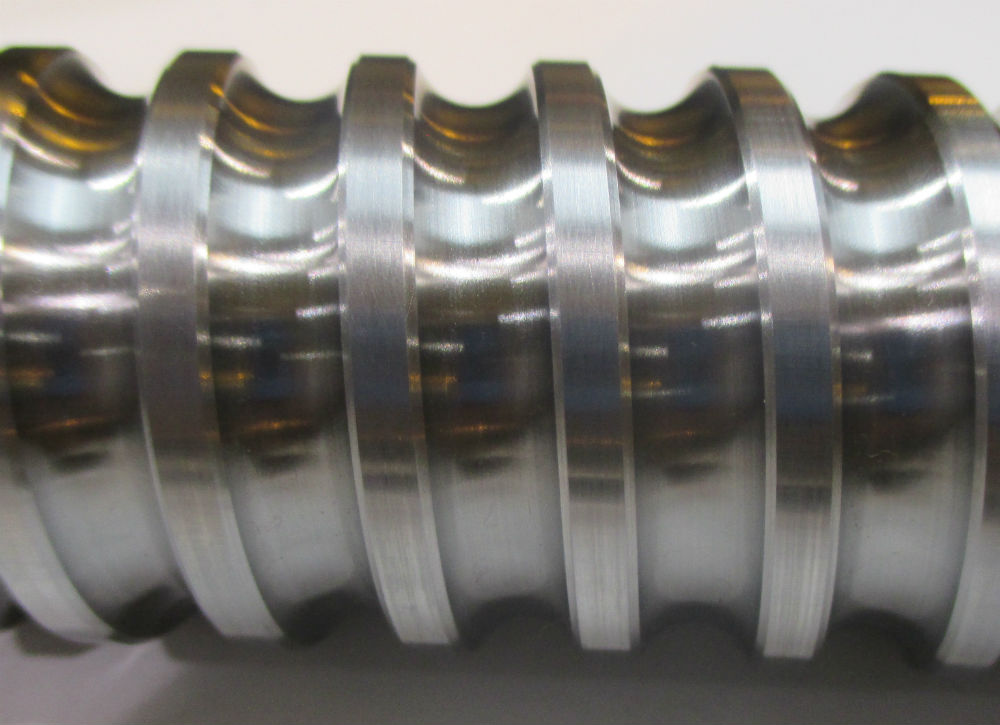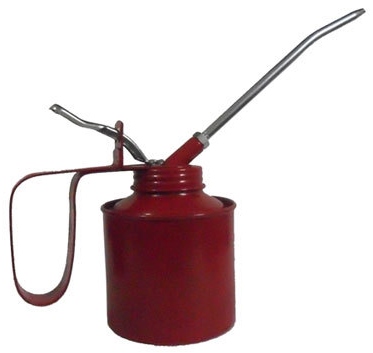Frequently Asked Questions
What is the difference between a precision ground and a rolled thread ball screw?
A rolled thread ball screw is manufactured by rolling a bar of steel between dies under extreme pressure to form the thread into a ball profile. They generally have a groove in the center of the “land” (or the crest of the thread) from the rolling process. Due to the lead inaccuracies from the rolling and heat treating processes rolled thread screws are often used in applications requiring less accuracy (but still have repeatability). They are usually used in lifting or transferring motion and not for precision positioning.


A precision ground screw is finish thread ground to the desired lead tolerance and is designed for precise positioning in precision machine tool applications.
Should I remove the end bearing assemblies off the journals before sending in my ball screw for repair?
Yes. If possible, all bearings, drive pulleys, gears, oil seals, etc., should be removed from the ball screw shaft prior to sending it in for repair. This will reduce the incoming inspection time dramatically and allow Barnes to better service all its customers in a timely manner. The thrust bearings on the ends of a precision ball screw should always be replaced while the ball screw is being reconditioned or replaced. By keeping the bearings at your facility, proper replacements can be purchased and ready to install on the refurbished screw.
If the ball nut has a removable housing, it is good to ship this with the screw and nut. It can be inspected for squareness and parallelism while the screw is being serviced and corrected if necessary.
I installed my reconditioned ball screw, but still have backlash or lost motion on this axis. Why?
There are many possible causes for lost motion depending on the application;
First, if the thrust bearings were not replaced, they could be reducing your system stiffness to the point where it is noticeable in the accuracy of the machine. Bearings should always be replaced when a screw is being reconditioned or replaced. Even if they look new, they will not reseat properly.
 Second; if the machine has dovetail type ways with a tapered gib to maintain accuracy on the slide, the ways could be worn or the gib over-tightened to compensate for the wear causing the slide to bind. If the slide is binding the screw assembly will torque up and give an appearance of lost motion. When the slide ways and gib are resurfaced, the accuracy will be regained.
Second; if the machine has dovetail type ways with a tapered gib to maintain accuracy on the slide, the ways could be worn or the gib over-tightened to compensate for the wear causing the slide to bind. If the slide is binding the screw assembly will torque up and give an appearance of lost motion. When the slide ways and gib are resurfaced, the accuracy will be regained.
Third; Screw alignment in the machine can sometimes cause lost motion. If the screw is not aligned to the ways or linear guide rails, the resultant bend that is induced into the screw shaft can cause a loping or whipping affect that can appear as error in positioning.
Fourth; Electronic malfunctioning can cause an inaccurate response in the ball screw to the motion control commands.
Fifth; it is possible that the housing or machine slide that the ball nut is mounted to is not perpendicular to the screw axis. This can also be caused by dirt or machining chips on the mounting surfaces.
If, after all these possibilities are exhausted, there is still evidence of lost motion, contact the Barnes Industries Sales Department for assistance.
Can my existing housing be modified to accept an external ball return system and how could this benefit my CNC machine?
Many ball nut housings can be modified for external ball return tubes. Barnes Engineers can quite often increase the load capacity of a ball nut assembly by 30-40% or more by redesigning an internal ball return system to an external ball return system (Tubes). A 30% increase in load capacity would result in an increase in ball screw life by more than 2-times. This is a substantial increase for the life of your CNC machine.

What are some general inspections I can perform prior to installing a ball screw in my CNC machine that will assure me of the accuracy of the screw?
Physical Inspections of the ball screw assembly;
- Arc bend or kink bend are best inspected between centers using a spar attachment for the indicator.

- Journal bend can be checked by rotating the screw in v-blocks with an indicator on the bearing journal
- Check bearing journal concentricity to major diameter of ball screw in v-blocks.
- Check bearing shoulder squareness to the screw axis.
- Check ball nut flange squareness to the screw major diameter by rotating the screw in v-blocks.
- Check ball nut mounting diameter concentricity to the pitch diameter by rotating the nut around the screw with the indicator on the mounting diameter.

What is the difference between drag force and drag torque and what does it have to do with the preload on the ball nut assembly?
The drag torque is measured with a torque wrench fastened to the end of the ball screw shaft, and measures the torsional resistance to motion caused by the friction between the balls and the raceway. The drag force is measured with a spring scale attached to a string wrapped around the nut outside diameter with the screw rotating at a constant rpm. A drag force check measures the force of pull at a certain distance from the axis of the screw. The preload on the ball nut assembly is the force between the balls and the raceway giving the ball screw assembly its stiffness required for positioning. The drag force and drag torque are measuring the resultant “drag” caused by this preload force, but are not measuring the actual preload itself. (See diagram)

What type of lubricant should I use for my ball screw assembly?
 Although ball screws are nearly frictionless in operation, all ball screws need lubrication. We recommend using what the machine manufacturer specifies in their literature. If that information is not available, we recommend using light way oil or a light lithium based grease without suspended particles (such as graphite). Barnes prefers oil over grease due to its ability to flush out foreign particles from the nut assembly which can cause pitting of the raceways. If lubrication is not used, the life of the ball screw drops by as much as 85%.
Although ball screws are nearly frictionless in operation, all ball screws need lubrication. We recommend using what the machine manufacturer specifies in their literature. If that information is not available, we recommend using light way oil or a light lithium based grease without suspended particles (such as graphite). Barnes prefers oil over grease due to its ability to flush out foreign particles from the nut assembly which can cause pitting of the raceways. If lubrication is not used, the life of the ball screw drops by as much as 85%.
Call 248.541.2333 Today visit our faq page for more information
